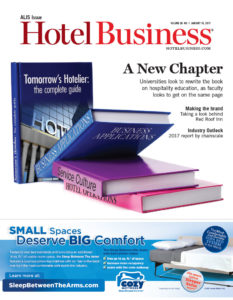Indicative of broader trends, hotel industry pundits foresee another steady year of rate and RevPAR growth for midscale hotels, with a slight ongoing dip in occupancy from the current lodging cycle’s 2015 peak. Limited new supply in the segment also continues to contribute to solid performance fundamentals.
Hoteliers immersed in the midscale sector told Hotel Business that minimal new competitive inventory in their respective markets provides cause for optimism that occupancies will remain stable in 2017. Therefore, incremental gains in ADR are likely to be the primary drivers for RevPAR growth.
“Midscale should slightly outperform the overall industry averages, as there is not as much concentration of this product in key markets that is being impacted by new supply,” said Mark Daley, president and CEO of The Generation Companies. “What new supply is coming online is generally above the midscale price point, so it’s not as directly competitive.”
Like much of the rest of the hotel industry, experts said that in 2017 midscale hotels will plot a steady, similar course as 2016, with a minor reduction in occupancy and modest gains in ADR and RevPAR. CBRE Hotels’ Americas Research is expecting midscale occupancy to fall -0.6% to 58.7% overall, with an ADR gain of 2.9% to $88.17 and RevPAR growth of 2.4%, to $51.71. STR is also projecting a similar performance, with a year-end 2017 occupancy decline of -0.3%, ADR growth of 2.5% and a RevPAR increase of 2.2%. Hotel owners told Hotel Business they had similar expectations for the segment this coming year.
“I think we’re going to be flat. I don’t think we’re going backwards by any means, but we’ll probably eke out a couple of points higher. I think there’s still a lot of ‘wait and see’ going on, but there’s a lot of people traveling,” said Mike Marshall, president and CEO of Marshall Hotels and Resorts. “On the select- and limited-service side, how much more can you push?”
Fortunately, not a whole lot of pushing is required in the sector at the moment. Occupancies will still hover near their 2015 highs, and the minimal new supply means operators won’t have to skimp on rate due to increased competitive pressure. CBRE Hotels’ Americas Research is expecting 2017 midscale supply growth of 1.4%, against demand growth of 0.9%, but sources said most of the “new” rooms are actually repositioning projects, rather than ground-up developments.
“In the economy and midscale segments, most of that supply change you see is, in fact, conversions,” said R. Mark Woodworth, senior managing director, head of lodging research, CBRE Hotels’ Americas Research. “It’s not new construction in economy and midscale, which would imply that any growth in that area is because of hotels dropping down in chain category.”
There is, however, one notable exception, according to sources: Hilton’s new midscale brand Tru, which is currently focused on the U.S. and Canada, and debuted in early 2016 with 102 signed deals already in place and an additional 30 hotels in various stages of approval. Tru properties will open in major markets like Atlanta, Dallas, Houston, Chicago, Denver and Nashville, but some question whether these trendy, millennial-centered hotels will soon price themselves out of midscale, moving instead into upper-midscale territory.
“In midscale, you really don’t have much new room supply, with the exception of Tru. That’s a brand that’s targeted toward that midscale sector,” said Bobby Bowers, SVP of operations at STR. “When Tru gets out there and we see how it’s priced, I find it hard to believe that it’s going to live in that midscale group. I think it’s probably going to go up, but we’ll see.”
But a relative lack of new-build rooms doesn’t mean midscale owners and investors anticipate a lackluster deal-making environment in 2017; rather, some expect to be actively trading assets this year. Insiders said multiple trends are developing that will spur a brisk hotel sales pace in the coming months.
“There is a large amount of hotel debt maturing in 2017 at a time when interest rates are rising and industry fundamentals are flattening. There are also an increasing number of hotels facing franchise agreement maturities and renewals that will require extensive property improvement plans,” said Daley, whose company is expecting to complete several acquisitions in 2017. “Both of these trends—and especially when both are at play—will create pressure for many hotel owners to sell. We expect those with ready access to capital and the ability to close quickly, like The Generation Companies, to have excellent buying opportunities in 2017.”

